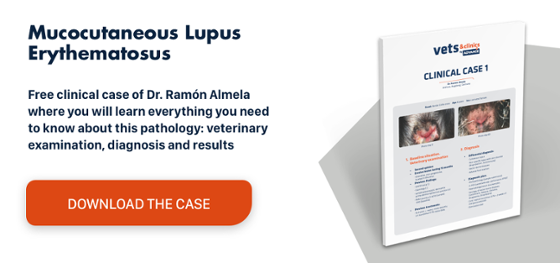Clinical signs of leishmaniasis in dogs: A brief review
Dogs with leishmaniasis manifest a highly variable clinical picture because the disease affects a wide range of organs and systems.
Leishmaniasis in dogs: clinical manifestations
Dogs with leishmaniasis manifest a highly variable clinical picture because the disease affects a wide range of organs and systems. The most important feature is its extraordinary clinical polymorphism with dogs displaying a wide variety of clinical signs, which is why it should be included in most differential diagnoses. Some dogs with leishmaniasis may remain asymptomatic for varying periods of time depending on their immune system.
As the clinical signs of Leishmania in dogs are not pathognomonic, a good review of the signalment, the anamnesis and a physical examination is very important to confirm the direct relationship between the dog’s clinical picture and a possible Leishmania infection.
In Spain, leishmaniasis in dogs is mainly concentrated in the Mediterranean basin and its peak period spans from late spring to late autumn. It affects all breeds, although some seem to be more susceptible, such as German Shepherds and Boxers.
In addition, canine leishmaniasis has a bimodal distribution, with a peak of affected dogs under 3 years of age and a second peak between 8 and 10 years.
Canine leishmaniasis: main clinical signs
The range of clinical signs of leishmaniasis in dogs include:
- General signs: Poor nutritional status including even cachexia, muscular atrophy, lethargy, pale mucous membranes, epistaxis, lymphadenomegaly, hepatosplenomegaly, lameness or inflamed joints, fever.
- Cutaneous or mucocutaneous:
- Alopecia: a thin layer of dry, dull, brittle hair. Hair loss occurs on the ears and around the eyes.
- Exfoliative dermatosis (localised or general)
- Ulcerative dermatitis (mucocutaneous junctions, paw pads or elbow calluses), papular dermatitis, nodular dermatitis, lesion on the nose (similar to pemphigus/lupus). Intradermal nodules or ulcers usually develop on the surface of the skin.
- Nail diseases: Abnormally long or brittle claws.
- Nasodigital hyperkeratosis: The main finding is excessive epidermal scaling with thickening, depigmentation (loss of skin colour) and cracks on the muzzle and paw pads.
- The vasculitis caused by the parasite visibly manifests as ear-tip necrosis.
- Ocular: Palpebral lesions, diffuse or nodular conjunctival lesions, corneal lesions (nodular keratitis, keratoconjunctivitis or keratitis sicca), sclera lesions (episcleritis or diffuse or nodular scleritis), diffuse or granulomatous anterior uveitis, posterior uveitis (chorioretinitis, haemorrhage or retinal detachment), glaucoma, panophthalmia, orbit lesions (granulomas or myositis). These lesions can lead to glaucoma or panophthalmia and therefore even blindness.
- Other:
- Renal: Glomerulonephritis is the most common kidney disorder. In dogs it manifests with proteinuria which may progress to nephrotic syndrome and sometimes culminate in kidney failure.
- Gastrointestinal: The classic digestive signs are diarrhoea with or without melena and vomiting, both related to colitis, duodenitis or secondary to renal problems. Chronic hepatitis is occasionally observed. Epistaxis, present in approximately 10% of cases, is one of the most complicated clinical signs to explain, as its pathogenesis includes vasculitis, thrombocytopaenia, coagulopathies, hyperviscosity and ulcerative inflammation of the nasal mucosa.
- Neurological:
The most common clinical signs are cutaneous signs, which occur in approximately 80% of dogs with leishmaniasis, followed by lymphadenopathy and general signs (fever, lethargy, weight loss and muscular atrophy).
Related posts:

